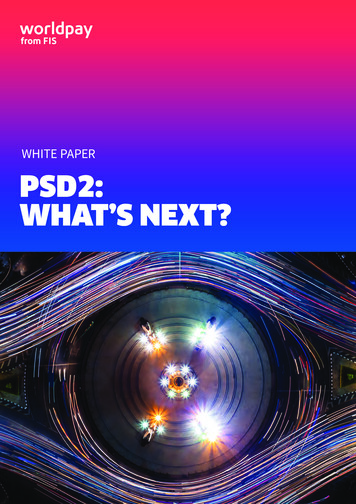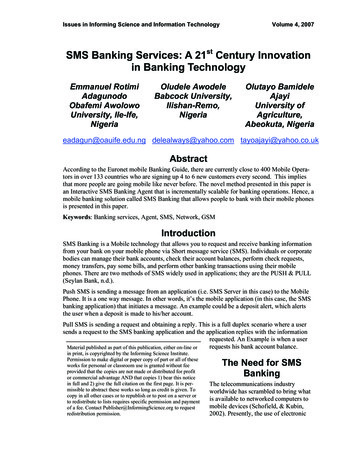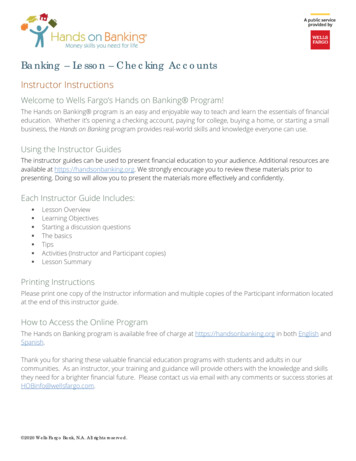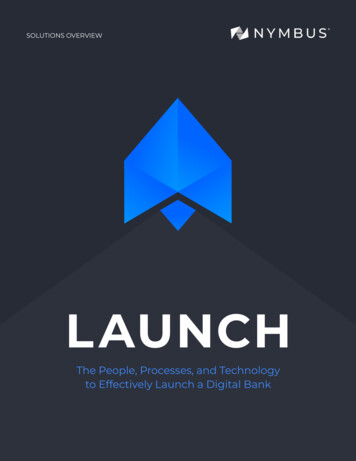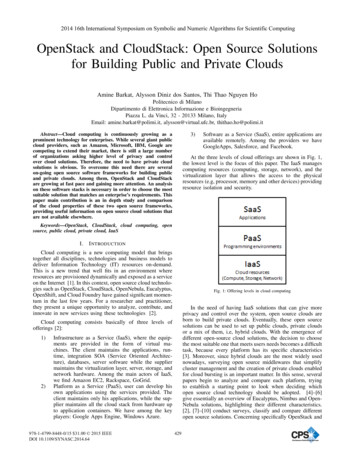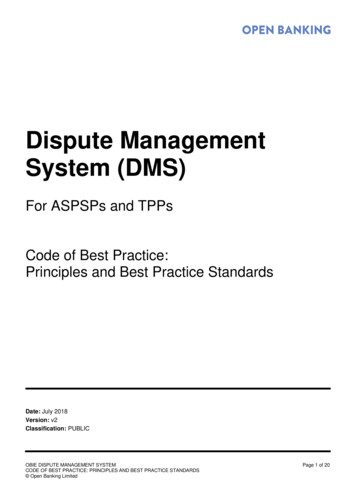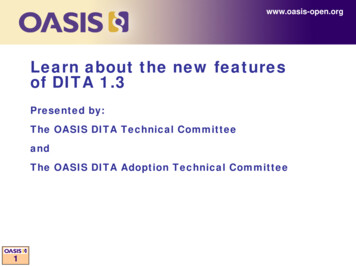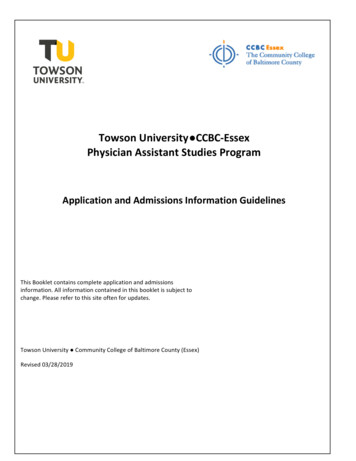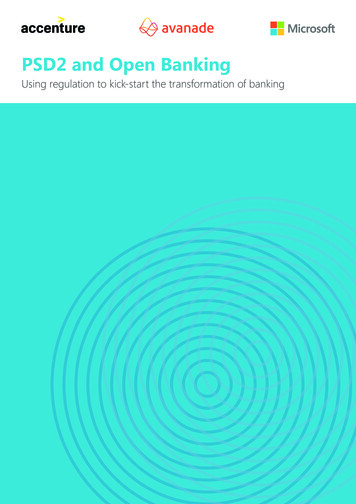
Transcription
PSD2 and Open BankingUsing regulation to kick-start the transformation of banking
It’s not just about technology.It goes far beyond that. It iseven the approach we taketo our business. It is howwe partner, how we createthe flexibility that speaksto the real-world needs ofour customers. That is thetransformation that is afoot.Satya NadellaCEO, MicrosoftSpeaking at Ignite 201502What’s
What’s insid06Is this the start of real transformation in banking?10A banking revolution?14So, what is driving this?21Foundations for the future30Avanade and Accenture’s Azure API Management Accelerators inside03
AbstractTHERE ARE ALREADY many documents availablethat describe the history and mechanisms of theSecond Payment Services Directive (PSD2). Thispaper does not aim to repeat these. Instead we aimto explore the risks, opportunities and technologicalimplications this brings for banks, paymentsschemes, fintechs, consumers and merchants.We explore where opportunities for innovation may developin the short, medium and long term and how PSD2 and OpenBanking initiatives can act as a catalyst to digital transformationin banking. This paper then looks at how Microsoft solutionsare positioned to help organisations looking to meet or exceedregulatory needs, and establish a core platform that builds onexisting investment and adds flexibility to meet future change,growth and partnership opportunities. In addition, it shows howbanks can respond to their PSD2 obligations through actionableAPIs that Microsoft has created with Accenture and Avanade,accessible via a sandbox described later in the document.04
The ultimate goal is theprovision of a singleexperience for customersthrough one interface – oneseamless end-to-end journeyto the desired customeroutcome.05
Is this the start ofreal transformationin banking?LIKE IT OR NOT, PSD2 and the UK Open Banking Standard are kickstarting a financial services revolution that will connect consumers,third party applications and banks in new ways. This is a revolutionstarting with regulatory-driven application programming interfaces(APIs) and evolving naturally into banks’ participation in a broaderAPI economy. Whilst PSD2 regulation mandates this base APIlevel for compliance across all banks in 2018, more progressiveorganisations will use this as a catalyst to talk at board levelabout disruptive digital transformation. They will assess the newchallenges and opportunities presented by traditional competitors,fintech start-ups as well as new market entrants from other sectors,such as big tech companies – who all seek to own part or all of aconsumer journey.06
Redefining the customer experience This first wave of PSD2 and Open Banking regulated APIs are designed as a smallstep to increase competition and innovation in the financial services industry. But itisn’t difficult to imagine these APIs being used in creative ways, combining servicesfrom different vendors and markets to form a single customer journey to a desiredoutcome. The customer experience would be defined by the purchasing context.Take the example of a car purchase: frequent car repairs, high fuel costs, imminentlease term expiry or other factors prompt or predict a need for a new car. Responding to the prompt, APIs facilitate research across multiple vendors,ask social channels for recommendations, secure a loan or credit check, checkavailability and place an order – all from a single app.The ultimate goal here is the provision of a single experience for customers throughone interface that combines the best of third party prediction, recommendation,analytics, payment, product choice, delivery and ongoing support services into oneseamless end-to-end journey to the desired customer outcome – in which paymentor purchase is a fundamental component.A seamless API journeyMultiple actors currently participate in the delivery of an outcome,but the ultimate goal is a seamless journey connected by APIsAnalyticsPredictthe comeSocial recommendationCustomer search,social apps, email,campaigns, eventsSearch and socialanalyticsMerchantportal/appPredictive analytics/machine learningCore products/servicesOpen banking/credit agencyapp/APIsBanks/fintechpayment app/APIsLogistics providerapp/APIsBanks/fintechinsurance app/APIs07
However, whilst APIs enable this, these new inter- and cross-domainpartnerships could easily push many current common bankingtouchpoints to be invisibly integrated as part of the experience. Themovement of money from one account to another could becomenothing more than a behind-the-scenes transaction, with the bank indanger of being relegated to a bit-part in the overall journey.Further, many other money management tasks will inevitably beautomated through artificial intelligence (AI) or trusted digital agentssuch as Cortana, Alexa or Siri, which automatically synchronise thefunctionality of a variety of apps from a diverse range of vendors. Inthis event, the most successful agent and apps are likely to be chosenfor ease of use and quality of insight, rather than brand and trust.Banks are therefore ushered into a new battleground of integratedservice, with the winners claiming the right to be a customer’spreferred digital point of entry into banking services. The customerexperience differentiators will be based on insightful prediction ofcustomer need, seamless integration, breadth of connectivity andassistive AI to support full lifecycle customer journeys.All this will take some time to materialise, but elements of thenew landscape will appear in the short term. And whilst customerexperience has always been a distinguishing feature for manybanks, their competition has only really ever been other banks.PSD2 and Open Banking regulation accelerates the introduction ofan API economy, expanding that playing field beyond traditionalbanking institutions and allowing recognised leaders in experiencemanagement to compete, setting the bar for customer experiencefar higher, and increasing every year.So, intelligent money management systems will automaticallymove funds between current and savings accounts, or evenbetween banks, based on real-time interest rate optimisationalgorithms. And third parties will provide the hands-on experienceof handling everyday interactions. In this world, how will bankscreate and maintain customer loyalty with their current channelsand data feeds, which are so under threat?08
This paper is our view on the answersto these questions – in three parts.123Introduce current regulationimplications and immediateimpactsArticulate a position on thepossible broader impact APIswill have on financial servicesHow Microsoft’s hybridintegration and intelligencecapabilities built on atrusted cloud will help yourorganisation stay relevantin this rapidly changingdigital world09
Is this a bankingrevolution?THE EUROPEAN COMMISSION has reviewed and modernised itsPayment Services Directive (PSD), to a new package of legislativemeasures on payment services – PSD2. Its main objectives are to driveincreased efficiency, competition and security whilst encouraging lowerprices for payments.At the same time, the UK Competition and Markets Authority (CMA) is drivingOpen Banking initiatives to increase competition, encourage new entrants anddisrupt the status quo and create a new playground for new business models.The CMA is ordering several UK high street banks to ‘open up’ and adopt newopen banking principles.PSD2: catalyst for transformationFor many PSD2 is the starting point for digital transformationDigital transformationSystems of intelligenceEngage yourcustomersPSD210Empower your Optimise yourTransformemployeesoperationsyour productsOpen bankingand API economy
Intelligent automationNatural interaction BOTsAPI economyPredictive decisionsCloudIntelligent BankPredicting what’s next for the customer: using systems of Socialintelligence to process (big) data – increased wallet share,new services and business modelsCRMPersonal finance managerRobo-advisoryImmersive BankProviding consistent customer experiencesand launching new campaigns quickly –higher brand loyalty, increased salesNew branches and ATMsRealtime marketingTraditional BankBank provides multiple channels fortrusted interactions with ntsDepositsTherefore, Open Banking and PSD2 are acting as a catalyst to incumbents andnew entrants as the start of a new data revolution – cementing the customerat the heart of everything they do. In the future if a customer wants to switchaccounts, a particular product or their bank (or perhaps we should say serviceprovider), they may be able to with a simple click, or a trusted AI-based digitalassistant may even have already done it for them. It’s no longer about loyalty,it’s about what works best for the individual consumer, who will ask how smartcan ‘I’ be with my money?Is this only a Europe-centric concern? No, whilst PSD2 in Europe and OpenBanking in the UK is paving the way for new business models and standards,this is the enforced start of a digital transformation of all banking and financialservices that reaches more broadly than the relatively narrow scope of this newregulation. Perhaps further regulation will be necessary, perhaps competitionwill force continued innovation.Either way, greater accessibility to banking data and services and new marketentrants will make it essential for banks to consider new approaches totransform products, optimise operations, empower employees and engagecustomers to stay competitive – and while Europe is forced by regulation tomove, the rest of the world will have to follow to maintain parity.11
The future of banking is agile, collaborative, ‘exposed’ and designed toencourage new business models – using ‘systems of intelligence’ in thistransformation. Two concepts and choices emerge here – the bank as amarketplace and banking as a platform. Common to both is an intelligent andconnected ecosystem in which integration is the core component and wherean API-enabled platform and marketplace is the key strategic consideration.And vitally, access to customer data drives higher level analytic and predictiveservices that create a competitive edge of intelligent customer insight androbo-advisory services.Marketplace banking offers complementary third party financial servicesproducts alongside a bank’s core product, for example a current account. Thebank curates a number of trusted third party providers to provide a morerounded set of financial services and offers these as either white labelled orperhaps as co-branded products. The key here is well-defined APIs to enableease and richness of integration with the third parties.In comparison, the banking as a platform concept creates a framework in whicha bank creates an open set of APIs (perhaps monetised) for any third party tobuild products and services from these – and of which the bank ultimately haslittle control. The PSD2 AISP (account information service providers) model ofopen access to transaction data and third party aggregator portals is a clearexample of this. The depth and breadth of the banking platform opportunityis driven by the scope and access of APIs provided, and by the level of uptakeamong third parties and fintechs.Access to customer datadrives higher level analyticand predictive services thatcreate a competitive edge ofintelligent customer insightand robo-advisory services.12
Certainly, of the two, banking as a platform has the potential to offer the endconsumer the broadest set of capabilities, but does come with some lackof centralised control of quality. (Read more about the API economy in theEmpowering the Digital Bank white paper from Microsoft).The answer, at least in the short term, is likely to be not one or the other,but a combination. Banks will choose to strengthen products in which theyexcel today and consider offering these services to others to white label andconsume and gain value through scale. In parallel, banks or fintechs maychoose to curate best-of-breed products from their own offerings and thoseof third parties – providing combinations that are compelling and unique. Ineither scenario, the bank that is most flexible to consume or offer products orservices through APIs has the advantage.13
So, what is driving this?WE SEE THREE FACTORS at play, forcing this inevitable change, andregulators acting as a catalyst to encourage nologyCustomer expectationsCustomer expectations change rapidly and will continue to do so. Millennialsand early adopters across generations are at the forefront here, expecting fullservice digital banking, being far from loyal to high street banking brands –and trusting tech brands to provide better service.More than ever a customer’s choice of bank is influenced by ease of digitalaccess and ease of integration with higher level services, as much as it iswith rates or premium account features or branch locations. Banking is fastbecoming just one step in the way of getting the ‘stuff’ you need. Banks needto adapt and adjust to this new attitude to maintain market share. (Find outmore about banking disruption at www.millennialdisruptionindex.com)Although, this new model disfranchises the traditional card model, existingdebit/credit card and PSD2 payment models will co-exist. According to a surveyon PSD2 conducted by Accenture in 2016, more than 50 percent of consumerswill use a PISP (payment initiation service provider) product that is secure andoffers extensive retail options. One in three debit card payments and one in tencredit card payments are expected to move to PISP by 2020.14
CompetitionToday’s high street banks have evolved numerous layers of organisation,process and technology designed to maintain stability and minimise risk.When all around you behave similarly, this status quo is maintained. However,these rules will not be followed by new banking entrants without the legacy,fintechs that specialise or don’t fall under the same regulatory scrutiny, anddisruptive entrants from other markets.As most of this new competition will struggle to compete directly on price,agility and customer focus are the two factors most likely to disrupt – and thismay well be attractive enough to make significant shifts in market share.Regulators, competitors, and customerexpectations are driving changeRobo-advisorsOpen API positsand lendingFintechsBanking licenseHigher capital holdingsMarketplace lending15
TechnologyThe checklist of potentially game-changing technologies continues to growand drive customer expectations – AI, bots, bitcoin/blockchain, biometrics,big data, predictive analytics and Internet of things (IoT) are just some of thetechnologies promising to change the art of the possible. Regardless of thetechnology, easing customer journeys, automating the tedious, providing justin-time and access-anywhere information and services are the promise of thenew normal today. Before long, even this list will become commonplace orobsolete and replaced by new innovation capturing the attention of fintechsand consumers alike. Ultimately, it is the flexibility to rapidly experiment with,adapt to and adopt emerging technologies that will allow for continuedrelevance in the marketplace. Uber is a case in point, bringing establishedtechnologies together to connect buyers and sellers via a marketplace whichfocuses on a great mobile experience, where payment is an integral but largelyinvisible by-product.Regulatory changeThe old regulatory barriers that had kept competitors at bay no longer seemto work. Some bank competitors have emerged that simply do not careabout regulation and have intentionally sought to thwart it – bitcoin, and thepayment ecosystem that has built up around it, a perfect example. Others, suchas the large (and growing) accredited investor community, offer the ability toloan money to individual borrowers through marketplace lending platforms.Rather than coming to the banks’ aid with new types of protection, regulatorshave thus far encouraged competitors, with measures such as PSD2, OpenBanking, and the US Office of the Comptroller of the Currency’s proposedfintech charter. Unbundling of banking services has become yet another toolfor the prudential regulator to employ in combating moral hazard.16
Improving customer lifestylesBanks can become a lifestyle empowerment partner to theircustomers rather than a transactional thenticationFrictionlessacross devicestavernmAutomated virtualassistanceenProactivealertsBanking as-a-platform by connectingand exploiting a broader range of digitalsolutions.Going further in helping the customerto get more value from their money andrelationship with you.Look for new value opportunities forcustomers and for the business.GodsoorgmendnsuCoBudgeting andforecastingCreate new and more open approachesto innnovation and partnering.ntioAlways onFinancingoptionsalthcarerel anPayarmnfoTraveRewardsand loyaltyMaintain trust and be the first for service,be it digital or physical.dianOpencomparisonntiod tionsBe the best at enabling customers to pay,access accounts, services, manage theirmoney and get help and support.UtilitiesSo, what is the opportunity presented by all this threatof change and potential disintermediation?The bank that is most embedded in Facebook, Skype, Xbox, WhatsApp, AutoTrader, JustGiving and others, that facilitates these scenario-based customerjourneys, will establish first mover advantage, mindshare and scale.This ’presence’ will soon be matched by others and the progression will be tobanks that can automatically create value chains personalised to the customer’sbuying requirement. Imagine this as an emerging real-time spot market, inwhich multiple potential suppliers transparently bid for a link in the chain tomeet your specific needs.17
Banks will play different roles, as they do today, but those that act in the ’Intelinside‘ or ’powered by Visa‘ role in this new distribution model will retainsome brand presence, access to data and the ability to aggregate and serveadditional value. As customers come back to their traditional banking channelsfor higher touch services such as wealth advice, taxation or mortgages, thisinsight will enrich the customer experience and brand value and so diminishthe threat of disintermediation.Maintaining access to data will become critical to participate in the largelyuntapped channel of access to personal financial data. The huge wealth of deepinsight into customer behaviour that can be gained through analysis of spendinghistory, financial health and financial products owned could be a lucrative sourceof income for those controlling access to it. There are of course enormous privacyissues to overcome before this becomes a widespread reality, but recognition ofand preparation for this potential future can only be a smart move.18
The PSD2 and Open Banking framework can be enhanced to create newbusiness models and revenue streams. The scenarios for innovation andgrowth in banking and capital markets are multiple: Banks can become aggregators forconsumers with multiple relationships N ew revenue streams will arise fromselling access to a bank’s core systems Banks can boost customer acquisitionand reduce attrition by becomingone-stop shops B anks can access data at the point oforigination to improve risk analysisand inform credit decisions (e.g. inagriculture, banks could partner acrossthe value chain with farmers to see theirusage of pesticides, fuel, water etc. toanticipate drought and effect on yields,which would impact loan serviceability) Crowdsourcing of new products will letbanks meet the needs of a fragmentedmarket Smaller banks can offer their
Banking in the UK is paving the way for new business models and standards, this is the enforced start of a digital transformation of all banking and financial services that reaches more broadly than the relatively narrow scope of this new regulation. Perhaps further regulation will be necess
